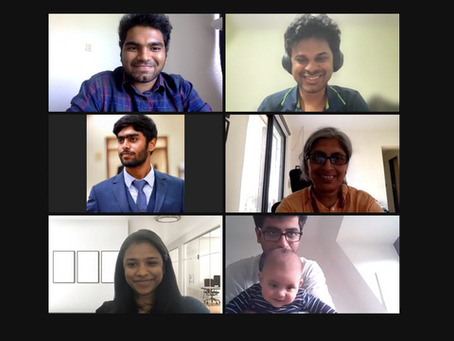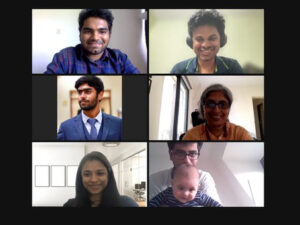
Without any warning, this countdown appeared on all our computer screens. It was the last day of our online cultural festival, Artists for a Cause (A4C), which was held almost entirely on Zoom. The last two events were going to end in just a couple of hours; and that was when this clock started ticking. For one slow, agonizing minute, we all silently watched our screens – our hearts in our throats – wondering if the whole festival was actually going to fall apart.
But maybe I should back up a little.
Difficult as this is to revisit, I would like to briefly hark back to April, 2021: when India was in the throes of a nightmarish second wave of COVID-19. Officially, the country was recording 300,000+ daily COVID cases and several thousands of deaths, day after gruesome day. No one really knows the true count of cases or deaths, but the horrifying images and stories of the time remain seared into our collective memory: smoke and fire billowing out of overfull crematoria; the mad scramble for oxygen, Remdesivir, and hospital beds; videos of doctors, nurses and relatives crying out for help; corpses floating in the Ganges.
Strictly keeping the cheap theatre of partisan politics out of this, it looked like the institutions – the System – built to protect the people had failed in a colossal and unprecedented way. Popular voices on social media were effectively running an informal healthcare bazaar – connecting pitifully desperate demand with vanishingly scarce supply. Numerous fundraising campaigns were launched – for medicine, food, oxygen, cash, etc. – and supply lines spanning the globe were hastily drawn up. When some of the campaigns and suppliers turned out to be scams, some people dedicated themselves to verifying leads. Lists upon lists of verified leads were compiled, organized, and shared far and wide. Thousands and thousands of people – not just in India but around the world – did whatever they could to help. At a time when the System had failed, the masses stepped forward and an emergent, self-organizing Response saved countless, countless lives.
One small part of this Response was the Help India Breathe campaign that we, at Humane Warriors, launched. The aim was to deliver food and oxygen concentrators to marginalized communities (e.g., people with disabilities, LGBTQIA+ communities, underprivileged castes, migrant workers, etc.). The campaign was launched on April 29, and we soon shot past our initial fundraising expectations. To close off our campaign, we decided to do something big – something that would get us one last, final spurt in donations. This “something” would be Artists for a Cause ’21: a 3-day cultural festival held almost entirely on Zoom, all the proceeds of which would go directly to our fundraiser.
It was an ambitious project, honestly, and a terrific exercise in firefighting. We were solving crises from start to finish. The first crisis: getting enough hands on deck. People were busy with other aspects of Help India Breathe, with their own jobs, personal problems, or just dealing with the stress of the situation in India. Even after we got enough volunteers on board, things didn’t get much easier. Liaising with artists, making an event schedule that worked for everyone, doing publicity, ensuring payments were made smoothly, brainstorming for every possible event day scenario, etc. – pulling off an event like this proved to be much more demanding and complex than we had initially expected. It was exhausting, stressful, and even felt a little hopeless at times.
Eventually, of course, we were able to pull it off successfully. The festival saw events on poetry, painting, photography, yoga, cooking, dancing, music, film-making, and more. We raised well over 3500 CHF through the various events, and used the festival’s platform to encourage people to directly donate to Help India Breathe as well. Overall, the attendees, artists, and volunteers who were part of A4C helped raise almost 7000 CHF. This was enough to fund 8000 meals and 3 oxygen concentrators for underprivileged communities across India. In those communities, families did not have to go to bed hungry. In those communities, COVID patients with serious symptoms but without money or influence were brought back from the brink of death. Lives were saved, and lives were bettered – and that is the most important thing.
But is that the complete, perfect picture? I think not. A full accounting of A4C’s impact, I argue, must include the lived experiences of the people who were a part of A4C. For instance, consider the case of Namrita: a middle-aged woman living in India who was attending a workshop on digital illustration. I had the chance to talk to her for a minute while I verified her payment details. Just as our conversation was coming to a close, she took a moment to thank me for what I was doing. I have to admit I was surprised. I was waist-deep in the organizational tasks of A4C, and didn’t really think about what the event meant for the artists and the attendees. For them, this wasn’t just any other cultural event. The attendees could easily learn digital illustration or listen to a talk on photography elsewhere on the internet for free. The artists could easily engage audiences through other platforms. But they chose A4C – they chose A4C with the understanding that their actions mattered. It wasn’t just about the art: this was about a nation’s loss, a people’s loss, and what we could do – as ordinary citizens – to alleviate some of that pain. “Thank you for letting me be a part of this”, I remember Namrita saying with remarkable earnestness. Thank you for letting me help.
We can’t really quantify Namrita’s feeling of having mattered, just like we can’t really quantify happiness or fulfillment or grief. However, just because you can’t measure something doesn’t mean that it doesn’t have significance. Despite being richer and healthier, we are living in a world where we are increasingly deracinated from our identities, isolated from our communities, alienated from our work, and deprived of a safe natural environment. In this context, how can we afford not to share how we feel? How can we continue to exclude, at our own peril, our experiences of joy and meaning?
To me, A4C was a uniquely memorable experience precisely because of how it felt. It was inspiring to see all these artists, attendees and fellow volunteers choosing to matter instead of just despairing over a broken System. It was also really cool to discover amazing, under-rated artists that I, hooked as I am on Netflix, did not know about. The stress of executing A4C only served to bring me closer to the other volunteers who were in the trenches next to me. And the crises? They all worked out anyway.
When the countdown reached 0, all the breakout rooms closed and everyone was thrust back into the main session. Artists, attendees, and volunteers poured in – all looking slightly confused. Luckily enough, we saw that all we had to do was to reopen the breakout rooms. Everyone would remain assigned to the event room that they were originally in. Disaster averted. Nonetheless, we felt sorry about the interruption and apologized profusely. “It’s okay”, Theresa, one of the artists, reassured us, “We understand.” And in just a couple of minutes, the final events were underway again. The crisis was dealt with, and we could enjoy the last couple of hours of a journey that was challenging, impactful, and meaningful. Not all of it can be quantified, but all of it does matter.



